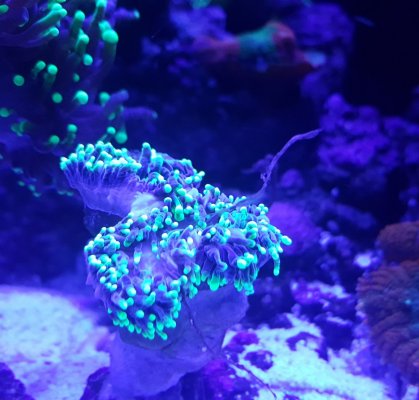- Joined
- Aug 31, 2019
- Messages
- 95
- Reaction score
- 155
It is discharging zooxanthellae. Corals do not have bile from a liver, or dead blood cells to turn their waste brown. If they ever discharge waste, it will be the left over remains of what they ate. If they ate pink shrimp meat, their waste will be pink.
All photosynthetic corals regulate the population of zooxanthellae inside them. Normally, these are minor adjustments that go unnoticed. Occasionally, there can be events of mass zooxanthellae expulsion. (Like pictured above) All of witch can be considered stressful. In an overly simplified view, for our purposes, and to better understand this process we can divide the causes into three categories.
1. General stress. Many factors can fall under this category. Excessive heat is probably the most common. Especially in wild corals of the south Pacific. Others could be infectious microbes like we see in the Caribbean. There is still a great deal of research needed before we understand all the causes of sudden stress related zooxanthellae expulsion.
2. Sudden PAR increase. Each zooxanthellae cell produces X amount of O2, based on the PAR (Photosynthetically active radiation/light intensity) it is exposed to. If the PAR suddenly increases, the amount of O2 produced also suddenly increases. This O2 can reach such high levels within the coral that it actually begins oxidizing the cell walls of the coral itself. In a desperate act of self defense, the coral can discharge large quantities of zooxanthellae all at once.
3. Excessive nutrients. Zooxanthellae reproduce at a rate that is directly influenced by the resources available to them. When nutrient levels (fertilizers ) are high, zooxanthellae can reproduce at a very rapid pace. This brings on the same symptoms as we see in example #2 above. While each individual zooxanthellae may not be producing any more O2, the growing colony as a whole produces much more O2.
In our systems, if a coral does this fallowing an increase in PAR, like moving from one tank to another, or upgrading lights, it's a good idea to reduce the PAR and give the coral more time to acclimate to the brighter light. If the coral is doing this on a regular basis, it's a very good indication that the nutrient levels in the system are excessive. This forces the coral to utilize energy for zooxanthellae regulation that could otherwise be used for growth, reproduction, or immunity. In such a case, it would be a good idea to step up maintenance and/or invest in more efficient filtration.
HTH
Peace
EC
It is discharging zooxanthellae. Corals do not have bile from a liver, or dead blood cells to turn their waste brown. If they ever discharge waste, it will be the left over remains of what they ate. If they ate pink shrimp meat, their waste will be pink.
All photosynthetic corals regulate the population of zooxanthellae inside them. Normally, these are minor adjustments that go unnoticed. Occasionally, there can be events of mass zooxanthellae expulsion. (Like pictured above) All of witch can be considered stressful. In an overly simplified view, for our purposes, and to better understand this process we can divide the causes into three categories.
1. General stress. Many factors can fall under this category. Excessive heat is probably the most common. Especially in wild corals of the south Pacific. Others could be infectious microbes like we see in the Caribbean. There is still a great deal of research needed before we understand all the causes of sudden stress related zooxanthellae expulsion.
2. Sudden PAR increase. Each zooxanthellae cell produces X amount of O2, based on the PAR (Photosynthetically active radiation/light intensity) it is exposed to. If the PAR suddenly increases, the amount of O2 produced also suddenly increases. This O2 can reach such high levels within the coral that it actually begins oxidizing the cell walls of the coral itself. In a desperate act of self defense, the coral can discharge large quantities of zooxanthellae all at once.
3. Excessive nutrients. Zooxanthellae reproduce at a rate that is directly influenced by the resources available to them. When nutrient levels (fertilizers ) are high, zooxanthellae can reproduce at a very rapid pace. This brings on the same symptoms as we see in example #2 above. While each individual zooxanthellae may not be producing any more O2, the growing colony as a whole produces much more O2.
In our systems, if a coral does this fallowing an increase in PAR, like moving from one tank to another, or upgrading lights, it's a good idea to reduce the PAR and give the coral more time to acclimate to the brighter light. If the coral is doing this on a regular basis, it's a very good indication that the nutrient levels in the system are excessive. This forces the coral to utilize energy for zooxanthellae regulation that could otherwise be used for growth, reproduction, or immunity. In such a case, it would be a good idea to step up maintenance and/or invest in more efficient filtration.
HTH
Peace
EC
thanks for this response













